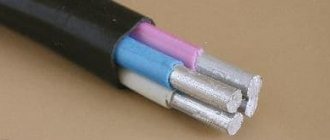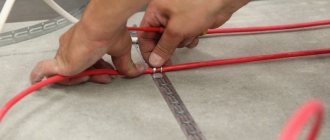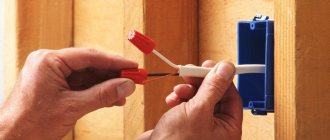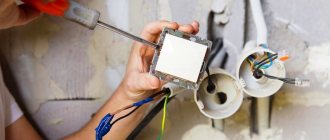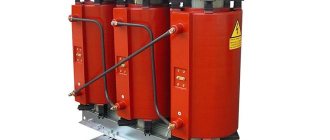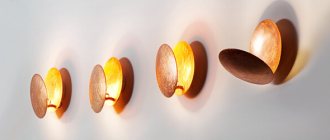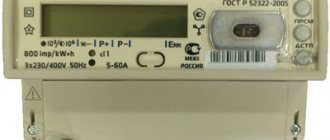Actual service life
Depends solely on the consumer and is determined by how the product was handled.
The actual period may either exceed or be less than that specified in the factory documentation for this product. The actual service life of the product is determined only by its technical condition. The service life of clean electrical equipment (sockets, switches, cords, socket plugs) depends solely on the consumer and his careful handling of the equipment. As for rough electrical work (cable and its connections), the situation is completely different. The fact is that modern electrical panels with the help of automatic circuit breakers protect the line in such a way that any of the automatic circuit breakers (provided they are chosen correctly) will turn off much earlier than the cable not only burns out, but even begins to heat up.
The warranty period for electrical wiring must be at least 10 years. If you, as a customer, are given a warranty of less than 10 years, then you definitely should not contact such “specialists”. Rough electrical installations must withstand at least five renovations and repairs. These updates are carried out every 5-7 years.
Thus, even under the most severe operating conditions, rough electrical equipment should last at least 50 years. After the nominal service life has expired, the network is re-tested under load. If, as a result of such testing, an electrical breakdown of the cable occurs, it is replaced. If the cable has withstood the load, then its operation continues. There are objects where old aluminum wiring has served for more than 70 years.
Modern cables in combination with spring terminals can work for at least 100 years without problems. Currently, the electrical cable is being tested on special test benches.
Test stands are mechanisms that simulate operation in conditions as close as possible to the real ones. Thanks to bench testing, it is possible in a very short time to fairly accurately predict what will happen to the cable after 10, 30, 50 and even 100 years of operation.
Test stands are designed for both cable testing and testing of its connections. Stands are enclosed spaces in which cables are laid in walls, corrugations, or simply in open connections. The cable is subjected to all kinds of stress. Such as may occur under real operating conditions. These are current loads, temperature changes, and humidity changes. A cable that has passed all tests is subject to further use without the need to replace it.
We are often asked the question: “What to do if the apartment has aluminum wiring?” In this article I will try to answer this question.
Useful tips
It is very important to correctly navigate the basic nuances of installing copper electrical wiring, so here are some tips:
The number of sockets must be selected individually in each case - according to the number and power of electrical appliances in use in a particular room
It is also important to consider the ease of their use so that you don’t have to limit yourself by turning on electrical appliances one at a time. When installing copper wiring, you need to take into account a possible increase in the load on the electrical wiring and the number of sockets in the future, since the electrics are installed for more than one year. It is imperative to have grounding in a residential area. Additionally, copper wiring must be protected by circuit breakers and RCDs
These devices will protect electrical wiring from short circuits, overloads and current leakage. When installing electrical wiring, the main thing is to correctly calculate the cross-section of all electrical wiring lines and choose the right protective devices - the reliability of the installed electrical wiring depends on this. In rooms with high humidity, the cable must be additionally protected with corrugation. Sockets and switches located in such a room must be protected from moisture. Also, lamps in such rooms must be protected from moisture. Despite the many advantages of copper wire, when purchasing, you need to make sure that it is not a TUSH cable, but made in accordance with GOST, otherwise the cores may not meet the specified characteristics. We talked about how to determine the cable cross-section before purchasing in a separate article.
Having made the wiring using a copper cable, you don’t have to worry about any problems arising with it and it will last for decades. Finally, we recommend watching a useful video on the topic of the article:
It will be useful to read:
- How to replace wiring in an apartment
- How to make a wiring diagram
- How to choose a circuit breaker
The dangers of old sockets and switches
Old electrical installation products: sockets and switches do not meet modern electrical safety standards. It is simply impossible to insert a plug into an old Soviet-style socket without additional effort, and when you try to insert it with a blow, the socket usually breaks.
Soviet socket
The main problems in old wiring most often appear in feed-through sockets. Pass-through sockets are called sockets through which electricity flows from the source (another socket) further to the next socket or consumer. Usually, where the wires are connected in the socket, a break occurs. And the worse the contact, the higher the load on the connection point. At higher currents, overheating and even fire are possible. One outlet can carry the entire load in the apartment, and if the outlet is old and constantly in use, there is a high probability of the contact weakening in it.
Pass-through sockets
In the best case, some of the sockets in the house stop working, but if things go wrong, they simply burn and melt. And the saddest thing is that no machine other than an RCD can save you from this.
Burnt out sockets
Pass-through sockets are the norm, they are allowed by the rules. Not a single modern wiring can do without them. This is primarily due to the enormous cable savings. Secondly, high-quality and correctly installed pass-through sockets do their job perfectly. The main thing is not to exceed the calculated load on the line with sockets. And try not to install more than 10 sockets per line.
Incorrectly installed or poor-quality sockets
The same, but not fully, applies to light switches. Of course, the load on switches is much less than on sockets, but they can also burn like the sockets in the photo. By the way, the switches are on a string, this is another sign that you have old wiring .
- Switch on a string
Old switches
A few more nuances regarding old sockets: the absence of a third grounding contact (this was discussed above); non-standard seat (no socket box); and weak fastening of sockets in the wall (over time they simply fall out of the wall).
The socket in the old socket box is supported by pieces of wood
Rules, orders and PUE for aluminum and copper wiring
Aluminum wiring
In accordance with the amendments adopted in 2022, wiring in residential premises can be made from aluminum and copper cables.
However, it is not aluminum wires from the 60-70s that are suitable for use, but modern alloys with some iron content. The main thing is to comply with the requirements given in the table.
| Line name | Smallest cross-section of cables and wires, mm.kv | |
| With cores made of aluminum alloys | With copper wires | |
| Group network lines | 2,5 | 1,5 |
| Distribution network lines for supplying residential premises (risers) | 6 | 4 |
| Lines from floor to apartment boards and to the settlement meter | 4 | 2,5 |
Prohibition of aluminum wiring in the apartment
Old-style aluminum wiring is prohibited from being used due to its recognition as a potential fire hazard.
In accordance with international standards, old-style aluminum wiring is recognized as a potential fire hazard and is therefore prohibited. Several facts that confirm this:
- There have been numerous cases of fires around the world caused by aluminum wiring. As a result, more than a dozen people were killed.
- According to statistics, in apartment buildings and country houses with an aluminum electrical network, the frequency of spontaneous combustion is 55 times higher than the number of fires in rooms with electrical wires made of other materials.
- According to chapter 7.1. PUE. Clause 7.1.34 this type of wiring is permitted for use only in structures that were built before 2001.
- To prevent fire? It is prohibited to connect copper and aluminum wiring, for example by twisting.
Copper and aluminum connection
Twisting an aluminum wire with a copper wire is unacceptable! Metals have different coefficients of thermal expansion. A series of uneven expansions and contractions will lead to loose contact. Loose contact, in turn, will regularly increase the heating of the twist.
If it is necessary to connect wires of different metals, it is important to ensure that there is no direct contact. This can be achieved using a threaded connection and a terminal block.
Should I replace the old aluminum wiring in my house with copper or not?
- if the wire is damaged;
- when insulation is damaged due to aging;
- after a fire caused by a malfunction of electrical equipment, for example, due to a short circuit.
The use of copper will help further reduce the risk of accidents. You just need to study the branching diagram and select the wire of the required cross-section. The work is carried out under the supervision of an electrician.
Copper busbars have tangible advantages when used in power supply conditions for individual housing. The only insurmountable obstacle will be the cost, which is 3-4 times higher than the price of a similar aluminum product.
Basic application requirements
If your choice falls on aluminum wires, adhere to the following requirements.
- The minimum wire cross-section is 16 kV. millimeters.
- Selection of wires in accordance with the expected loads.
- Ensuring reliable contact. One of the best options is to weld the wire, but such a connection requires a special tool.
Now, knowing about the advantages and disadvantages of aluminum wires, you can make your own informed choice.
Advantages and disadvantages of aluminum wiring
It should be noted right away that electrical wiring made of aluminum is not considered to be of the highest quality or reliable. One way or another, it is this type of system that is installed in most old apartments. This type has the following advantages:
- low weight (aluminum alloys weigh much less than other materials that are used as conductors of electrical energy);
- resistance to corrosion (aluminum instantly oxidizes upon contact with air, forming a protective film on the wire).
Today, aluminum in electrical wiring is often used to create power cables, where the price of the material and its weight are extremely important. A striking example is SIP cables, the cores of which are made of aluminum.
However, in modern new buildings they prefer not to install aluminum-based wiring. This is due to the following disadvantages of this material:
- high degree of fluidity (aluminum stretches well, which is a disadvantage when making screw connections of wires);
- fragility (during long-term use, aluminum cables will break, especially when overheated and under significant loads).
These shortcomings lead to a short service life of the entire installation. The approximate service life of aluminum wiring in an apartment is up to 26 years.
Flaws
Aluminum wiring is characterized by high electrical resistivity. This resistance is equal to 0.0271 Ohm x sq.mm/m. Taking this fact into account, the latest editions of the PUE note that in an apartment or house you can only use aluminum wiring whose cross-section exceeds 16 square meters. millimeters.
Ultimately, it turns out that to ensure the required level of throughput, you need to use a cable with a large cross-section. In other words, you need to install wiring that is thick. If we compare copper wiring, it has an electrical resistivity that is equal to 0.0175 Ohm x sq. mm/m.
This wiring is more efficient and for use in the home you can use copper cable with a smaller cross-section. As noted above, aluminum is capable of oxidizing and the film formed during this process has poor conductivity. There is one more nuance here: this film is formed from the top of the wire. As a result, there is a slight decrease in its cross-section, and as a result, the resistance increases.
Since the film on aluminum wiring has a high resistance, the transition resistance increases at the junction of individual parts of the wire. As a result, it manifests itself in heating of the wiring in such places. In situations where the load on aluminum wiring increases, it begins to heat up. If the wire has a sufficient cross-section, then there is nothing to worry about. However, if the wiring is not designed for such a load or is used beyond its normal service life, then this will necessarily lead to its heating.
The last fact can be called very bad for connection points. The fact is that when aluminum is heated, its shape and ductility change. Of course, the wire expands. After the load has disappeared and the cable has cooled, it takes on its usual shape. However, after repeated repetition of such processes, the contact between the ends of the electrical wires weakens.
Aluminum is also highly brittle. It increases greatly after it overheats. As for the service life, for aluminum wiring it is 25 years. After this, you need to install a different type of wiring.
How to extend the life of wiring?
With proper selection of cable diameters, proper quality of materials, and determination of the calculated current load depending on the equipment in the apartment, the wiring will last a long time. Improved cables that are combined with spring terminals are reliable in operation. The qualifications of the electricians who carry out the installation are also important.
The service life is increased by permanent connections when laying aluminum wires - welding, soldering and crimping.
To extend service life, use welding of aluminum electrical wires. The work is carried out using carbon electrodes. The soldering method is performed with special materials and electrician tools: soldering iron, rosin, solders.
Electrical networks after pressure testing are used longer than standard periods. Press pliers, hollow rods and sleeves are required for crimping work.
To increase the service life of the wiring, it is necessary to correctly calculate the size of the cross-section of the wires, which affects the resistance indicator.
The installation of fire protection systems with a control value will protect the installation of electrical wiring from overheating.
For general lines in houses, you need to choose a cable with a rating of 100 mA; in certain areas of lighting sources, a figure of 10 mA is required. If the indicators are exceeded, the USO will turn off automatically.
Compliance with the requirements for the location of switches and sockets will extend the service life. The height of switches in rooms must be at least 1.5 m from the floor. Sockets are mounted at a height of 0.5–0.8 m from the floor surface. In bathrooms, power supply must be supplied from separate transformers.
To increase service life, it is important to follow the rules for laying cable channels. Wires are placed strictly horizontally or vertically
According to the standards, the distance from gas pipes is recommended to be no less than 0.4 m. Horizontal sections are laid at a distance of 150 mm from the ceiling.
Operating rules
The apartment has many household appliances that run on electricity. Based on this, the edited PUE indicates a minimum cross-sectional indicator of 16 square meters. mm. This parameter concerns the wiring that is used to electrify the apartment.
When performing installation work with aluminum products, one more rule must be observed: clamp contacts must be used to connect wires. To prevent the metal from oxidizing, a special lubricant is applied to it. This method of connecting individual elements will minimize the level of contact resistance.
There is another option, relevant for installation in a junction box. The exposed rods are connected to each other by welding. This is a labor-intensive process that takes more time. Therefore, craftsmen often resort to clamp contacts. However, the qualitative result of using the second method will be higher.
When partially replacing old wiring, it is often necessary to connect copper conductors with aluminum ones. If you do this directly, the following happens:
- oxidation and weakening of contacts;
- heating of the cores at different resistances;
- melting of the insulating braid and exposure of metal;
- short circuit and fire of materials.
Electricians connect dissimilar wires in safe ways:
- Bolt, washers and nuts made of steel. Galvanized parts are not recommended. The connection turns out to be cumbersome, but the effectiveness of such contact has been tested in practice. The main thing is that the exposed parts of the wires are not allowed to come into contact with each other.
- A clip called “Nut”. In this case there is no need to cut the wire. It is enough to clean a small area that will be placed between small metal plates. When using this type of clamp, you should pay attention to the material. Typically, they are made of stainless steel, which can cause the wires to overheat. The contacts are placed in a “shell” made of refractory plastic.
- Terminals into which bare metal is inserted. Inside the clamp there is a paste that prevents the oxidation process. Craftsmen recommend using them only for lighting fixtures.
- Pads. Their use will require periodic tightening of the screws - approximately every 6-8 months. When choosing this clamp, you should make sure of its quality.
The best option for connecting dissimilar wires is crimping. The essence of this method is that the veins are stripped of oxide and covered with hot tin. Next, the wires are inserted into the GML sleeve, which is pressed.
To ensure tightness, the contacts are treated with an adhesive heat-shrinkable compound. It is important to be careful with aluminum, which by nature is a soft and brittle metal.
When choosing wires, it is worth considering the level of load that they can withstand depending on the cross-section. For example, 2.5 mm corresponds to 4.4 kW, 10 mm - 11 kW, and 70 - 36.3 kW.
Pros of aluminum
This material for laying wiring has certain advantages:
- Ease. Compared to other materials, aluminum wiring has significantly less weight.
- Resistant to corrosion. Aluminum material is less susceptible to destructive effects. When this type of conductor interacts with air, oxidation occurs. But due to the formation of a film on the cable structure, the material is reliably protected from further destruction.
- Price. Aluminum itself is an inexpensive metal. Therefore, it has found wide application in the manufacture of power conductors. Due to its light weight and affordable price, aluminum is considered the best option for laying air inlets.
- Large selection of different types of conductors. If, when renovating a room, it is necessary to install and connect power cables, then you can use SIP-type products. To implement internal wiring, the APBPP, APPV, and APV options are used.
The Chipdip channel spoke about the features of using such cables, as well as their advantages.
Properties of aluminum wiring
Aluminum wiring is resistant to mechanical stress
Aluminum is not the best option for indoor wiring, but the material has several advantages over its analogues. We are talking about low weight, which greatly simplifies installation work, provided that a large amount of aluminum cable is required. The cost is lower compared to copper. These two main advantages became decisive when choosing types of wiring during the construction of structures in the USSR.
Another important feature of the material is its resistance to corrosion. However, aluminum is highly oxidized when exposed to air. As a result, a film is formed that serves as protection against further damage to the wiring. This film has poor conductivity, which can be attributed to another disadvantage.
- When oxidized, copper does not lose its conductive properties.
- Has a long service life.
- The material is more resistant to mechanical stress, for example, bending, twisting, etc.
During oxidation, films are formed in both cases, but each has different conductive properties.
Aluminum fluidity
Aluminum is several times softer than copper
First of all, you need to know about the physical and chemical properties of aluminum. The substance belongs to the group of fluid metals; it is several times softer than copper. This is a significant drawback, since homeowners need to regularly check and, if necessary, tighten all screw contact points, for example, in sockets, automatic machines and terminal blocks. This is very inconvenient if there are 10 or more sockets in the house, which need to be disassembled, tightened and installed in their original place every six months.
Flexibility and fragility
The second feature of aluminum cores is fragility and fragility. If you bend them several times, they will break off without much effort. It takes a lot of effort to deform copper.
Connecting aluminum to machines
Aluminum and copper are not galvanically compatible
The third feature of the material is the contacts of switching equipment. For RCDs, switches, voltage relays, contactors, terminal blocks and starters, they are initially made of copper or brass.
If you directly connect brass-aluminum = copper-aluminum contacts, a galvanic couple is formed, accompanied by strong heating of the junction and the formation of oxides.
Core cross-section
Another feature of aluminum wiring is the need to increase the cross-section of the wiring strands. If previously it was enough to use cables with copper conductors of size 2.5 mm2, now there is a need to lay at least 4 mm2.
Copper wiring
When buying or building a house or apartment, it is advisable to use this type of wiring. However, keep in mind that by replacing the wiring in the apartment you have not yet received a reliable network that can withstand heavy loads. Do not forget that the input cable from the staircase panel to the apartment in old apartments is always made of aluminum. This section should be replaced, because its conductivity is now the weak point of the new network.
Advantages of copper wiring
Comparing the parameters presented below with the parameters of aluminum will allow you to make the right choice in the future. Copper, as a material for electrical wiring, has a number of advantages, which include:
- good conductivity (even after oxidation, the film on the surface does not interfere with the passage of electric current);
- service life reaches 50 years;
- high mechanical strength (the core can easily withstand bending and twisting up to 10-15 times);
- ease of installation (the industry produces several types of wires with different parameters and cores that are convenient to work with).
There is probably only one downside to a copper home network - its price, however, when it is necessary to perform high-quality wiring, give preference to this material.
In construction stores you can purchase wires made of zinc alloys coated with copper plating. They are cheaper than copper ones, however, the characteristics of the materials are inferior to wires made of pure copper.
If there is a shortage of funds, it is better to carry out combined wiring, power the socket group separately with copper wires designed for high current, and the lighting circuits with aluminum. However, keep in mind that the connection between aluminum and copper is made only through special clamps or connecting blocks, which prevent direct contact between copper and aluminum, which causes severe oxidation of the latter. Due to oxidation of the joint, the resistivity of the contact increases, heating and eventually burning occurs.
Having examined the characteristics, it is easy to come to the conclusion that it is better to use copper for installation work, however, if necessary, you can make the network from aluminum, but you will just have to monitor it more carefully. It is necessary to choose one or another type of wiring taking into account electrical safety requirements, because this determines how long the network will last without the need for specialist intervention.
Actual service life
It is this indicator that is most interesting to the owner of the premises. At the same time, in practice, this is where the biggest difference is observed, since the actual service life of electrical wires depends on a lot of factors that were listed just above. If the wiring is done correctly, the installation is carried out in compliance with all the requirements of electrical construction norms and regulations, the load power does not exceed the design value, and so on, then the wiring can last a hundred years. But if at least one of the many conditions is not met, the service life is shortened.
Another example: the cable powers a triple outlet in the kitchen, to which a microwave oven, coffee maker and electric kettle are connected. Under normal conditions, these devices almost never operate simultaneously. But all of them can be included, albeit for a short time, when preparing or holding a large family celebration. Even a short-term peak load will reduce the service life of electrical wiring.
Overheating is a separate issue. It can be caused not only by excess load, but also by external factors. For example, after installing cable lines, a fireplace was installed in the apartment and as a result, some wire ended up in close proximity to the chimney. Constant heating, at worst, will lead to damage to the braid (and, naturally, to a short circuit); at best, to a change in physical properties, which will reduce its service life.
This is one of the first questions raised when replacing wiring as part of a major renovation in a residential building. In general, the answer to this is most often unambiguous - copper.
There are enough reasons for this - copper has lower resistivity, higher electrical conductivity, and almost twice the maximum power load for the same cross-sectional area. And the service life of copper wires is longer - 20-25 years (nominal) versus 15-20 for aluminum. But there are some nuances.
If something changes, then everything will change completely. Firstly, the connection between the copper and aluminum core is a weak point in the wiring
even when using a terminal made of a third metal (direct twisting in this case is generally unacceptable, since copper and aluminum form a galvanic couple). Secondly, a partial replacement in order to increase wiring in some loaded area (for example, in a kitchen with a full set of household appliances) will not yield anything. A copper cable laid in the walls directly in the kitchen can actually cope with the increased load on its own, but an aluminum cable running from the apartment panel to the junction box cannot.
Another point worthy of attention is the economic feasibility of such a replacement. A copper core is still more expensive than an aluminum one, and if the house is not “packed” so much that the wiring really requires reinforcement, there is no point in changing it just because “aluminum is out of fashion.”
So, if the house is not crammed with household appliances, and the repair budget is limited, then you can change (if there is such a need at all) to aluminum. The only caveat is that in this case it will be necessary to carry out some kind of prophylaxis every two to three years. Its essence is to tighten the clamping screws in switches and sockets. Aluminum is plastic, the force exerted by the screw (or the contact pad pressed by it) leads to its deformation, the contact weakens over time, and poor contact is the most common cause of fires due to electrical wiring.
I think all owners of apartments and houses sooner or later are faced with the question of replacing electrical wiring, its rational use, advantages, disadvantages, service life, and so on. Today we will try to explain to our readers as easily and clearly as possible all the pros and cons of using aluminum wiring, and we will also figure out whether it is worth changing it to copper or not.
Solder boxes and twists
Standard location of junction boxes
In old electrical wiring, twists are the norm. Good quality twist, no worse than a bolt clamp. The main and necessary condition is that all twists and connections of wires must be located in junction boxes, which serve as a place for safe switching (connection) of wires. According to the rules, it is not allowed to block access to junction boxes, cover them up or cover them with wallpaper. Typically, junction boxes with twists are located above the light switches under the ceiling.
Horrible old twists
Twists of aluminum wires in these places become unusable over time, especially with high humidity and poor-quality installation. Signs of problems in the junction box are: blinking lights, electrical crackling under the ceiling, burning smells (not always obvious), or a partial absence of light in the apartment. In such cases, it is necessary to look for and open old junction boxes in order to sort through (reconnect). To do this, unravel the old strands and place the wires on special terminal blocks , having previously treated the ends of the wires.
Terminal blocks for connecting wires
A fairly common (even too common) and unpleasant problem is the twisting of copper wires with aluminum ones. The fact that you can’t do this should probably be taught in school! And not many people know that this is one of the main causes of fire. Thin wires with a cross-section that does not correspond to the load are the second factor causing fires.
Any wire that passes current through itself heats up, and it heats up in direct proportion to the load. That is, any wire can be heated like a soldering iron - just apply a good load to it. If you see that, for example, a household heater is hanging on thin wires, turn it off and call an electrician. Old electrical wiring is the most common cause of fire!!!
How not to do it
Is it worth changing aluminum wiring in an apartment or not?
In old houses, where aluminum wiring has rotted and crumbles when you touch it, there can be only one answer - it is urgently necessary to replace it with copper wiring. Of course there will be costs, but with old electrical wiring you can lose much more.
Aluminum wiring in the apartment
Sometimes aluminum wiring can be in satisfactory condition when it has been used in dry areas and has not overheated. In terms of composition, Soviet aluminum complied with GOST, which could withstand repeated overloads and did not have the same fragility as today's Chinese aluminum, and Russian aluminum as well.
It took a lot of effort to break Soviet aluminum. The cross-section of the aluminum wire of that time corresponded to GOST, not like now, a wire cross-section of 2 mm² is called 2.5 mm², etc. In addition, the aluminum wire contains additives that reduce its cost, but do not improve its characteristics in any way, rather the opposite.
Another paradox: if previously the permissible rated current of an aluminum wire with a cross-section of 1 mm² was equal to 4 A, now it has become, according to the new GOST, equal to 7 A (for small sections). Despite the fact that the quality of the aluminum wire has deteriorated and the cross-section has been reduced.
Dependence of rated current on the cross-section of aluminum wires
If the old aluminum wiring is well preserved, and the number of household appliances has increased significantly, that is, the load on the electrical network in the house has increased, it can be recommended not to touch the old aluminum wiring in the apartment, but to install a priority relay.
With this load control relay, you can use 2 times more power from household appliances without upgrading the electrical wiring, due to the sequential connection of the devices. If you do not have an electrical panel in your apartment, then you need to install it. Do not install a priority relay in the driveway panel. You can also install an introductory automatic switch in the electrical panel instead of plugs in the access panel.
Another option can be used with a small alteration of the electrical wiring in the apartment, if the aluminum wires are in good condition. The main load current falls on household appliances such as a washing machine, boiler, microwave oven, i.e. the kitchen bears the heaviest load. In this case, you can replace the aluminum wires with a copper cable only in the kitchen.
The cost of such electrical wiring upgrades will be low. From the access switchboard you need to run a copper cable with a calculated cross-section for the load to the meter in the apartment and install a panel with an input machine, a machine for a washing machine, and sockets. It is also advisable to install an RCD, a voltage relay and a priority relay.
RCD is necessary for safety. We definitely install a voltage relay, because you have old electrical wiring and the probability of a zero break is very high. It is cheaper to install a voltage relay than to purchase expensive household appliances again. In the entrance electrical panel, you need to replace all the aluminum wires with a copper cable and connect it to the terminals of the input circuit breaker of the new apartment panel.
Grounding (if it is not available) can be taken from the electrical panel housing in the entrance with a bolted connection. It is better to run a separate copper cable from the apartment panel for all kitchen sockets. If there is an electric stove, the cable must also be separate, from the meter through the machine to the stove socket. The kitchen lighting can be left untouched.
Installation of wiring along the baseboard
A separate automatic switch is installed for the air conditioner in the rooms, and a copper cable is led from the apartment panel through a plastic cable channel to the baseboard. Modern baseboards have channels for electrical wiring. The cable is brought along the baseboard to the socket location, and raised to the socket through the cable channel.
Such an upgrade will cost you much less than replacing electrical wiring throughout the apartment.
The main reasons for changing wiring
Repair is an expensive undertaking. And besides being expensive, electrical wiring is also a rather dangerous matter if you do not pay due attention to this matter. Previously, in the 1960s, aluminum was used for conductors due to its comparative cheapness. The weight of the metal influenced the wiring when it was used in high-voltage lines. An aluminum busbar weighs much less than a copper one.
Copper wire began to be used:
- Laying communications.
- Designing electrical equipment and engines.
- For transformer windings.
When choosing a material, an important criterion is the level:
- Specific gravity.
- Conductivity.
- Sections.
- Heat transfer coefficient.
The main reason for changing conductors is the safety of residents, preservation of equipment, and also:
- The service life of the wires has expired - copper ones can be used for 20 years, aluminum ones for 15.
- The number of household equipment has increased and, as a result, the load on the electrical network has increased.
- Malfunctions appeared in the form of sparking sockets, smoke, and switching off machines.
- When repairing and remodeling a building.
- There was a need for additional connection of devices.
Instead of completely replacing the cable, partial addition of busbars for new equipment is allowed.
Some generally accepted GOST standards for electrical networks
The location of electrical networks in the house must comply with certain norms and standards. Below is a list of some provisions of the Interstate Standards (GOST) that must be complied with.
- Meters, sockets and junction boxes should be located in easily accessible places;
- The height of sockets is 30 cm, switches are 90 cm;
- If there are any metal objects or elements nearby, the sockets should be placed 50 cm from them;
- Installation of sockets in the toilet is possible only if they are equipped with water protection;
- The required number of sockets in the kitchen is 3, in other living areas - 1 socket (socket per 6 sq.m.).
Rules for different types of wiring
For each type of electrical installation, you must adhere to certain rules.
The closed type is the safest, since when used, all wires are hidden and protected from mechanical stress. But it is a rather long and labor-intensive preparation procedure, namely, you need to at least prepare the “tunnels” in the wall. This method is good to use if your walls are lined with plasterboard, then to attach the wires it is enough to place the wiring behind the sheet.
Open wiring is the easiest way to lay wires. The advantage of this method is the ease of replacing or repairing the cable if damaged. In most cases, it is used in utility rooms.
The combined method of laying electrical wiring combines a closed and open laying, which simplifies the task, but nevertheless it has its own standards. Boxes for laying lines are chosen mainly from plastic; they are more practical and quite reliable. There must be free space in the box to accommodate all the wires.
It is necessary to use special flat wires APRV, APR. In the presence of flammable walls, asbestos insulation was previously used (thickness according to standards should not be less than 0.5 cm). However, today there are other safe materials with excellent insulating properties. The insulating layer is located between the wall and the wires, and in the event of a short circuit it prevents the wall from igniting.
Disadvantages of aluminum wires
The disadvantage of aluminum wiring in an apartment building is the “fluidity” of the alloy and rapid oxidation. It is necessary to regularly tighten screw connections in switches and sockets, since connections with other metals and substances can deteriorate.
Oxidation of wires causes an increase in resistance at the joints, leading to heating of the wires even under low loads. Cracks may form at the bends of the cables, and urgent replacement of the electrical wiring will be required.
In apartment buildings, the number of powerful appliances (washing machines, electric ovens) is growing. Household appliances have a lot of power, and when using old wiring, there is a risk of failure of the power supply system and a fire.
The material is more fragile than copper wiring, so aluminum cables can break when pulled. Among the disadvantages is the tendency to heat up due to high resistivity values. When the wires are frequently heated and cooled, the contact connections become loose.
The main disadvantages of the “old wiring”
Old aluminum wiring was laid at a time when there were no powerful energy consumers in the apartments of Soviet citizens: washing machines, food processors, vacuum cleaners, microwaves and other modern equipment. Thus, the cross-section of the conductors is simply not designed for such loads, which becomes a frequent cause of fires.
Operation is also dangerous for the following reasons:
- High creep rate.
- Low plasticity.
- High temperature threshold.
- Tendency for contacts to enter into a chemical reaction.
- The occurrence of corrosion when combined with certain other materials (steel, brass).
Creep
Old aluminum alloys of grade 1350 “creep” under loads. This implies a slow process of deformation.
Aluminum creep and contact weakening Source elec.ru
Modern aluminum conductor is characterized by greater resistance to creep, similar to that of copper. This effect is obtained due to the increased content of iron particles.
Plastic
Aluminum wiring grade 1350 was used strictly in the cold-hardened state H19. Being in this state, the alloy acquires a tensile strength value that is only slightly higher than the yield strength. In addition, the relative elongation is only 1.5-2%. This explains the increased “fragility” of aluminum cores and their sensitivity to cuts and dents on the surface.
Changes in the limits of strength and ductility during cold hardening and annealing of aluminum Source Spkab.ru
Wiring life
When installing electrical networks, it is important to determine the service life of aluminum wiring. Manufacturers, building designers and electricians use different parameters for operating electrical systems
The service life of wires can be nominal, warranty, or actual. The relationship between different indicators will help plan the replacement of electrical wiring in order to prevent drying out of connections, cable fragility and the risk of short circuits.
Nominal
When calculating the nominal indicator, factors of product performance are taken into account. There are lower and upper limits for service life. Indicators are important for theoretical justification of building projects and are used by designers when developing electrical wiring systems.
When determining the nominal designation, the time during which the cables will operate properly if the operating rules are observed is taken into account. Cables that operate at temperatures of –50…+50 °C have a load of no more than 660 V and a nominal service life of 25–30 years.
Electrical cables must be tested after completion of the rated service life. If failures occur, you will need to change the wiring when renovating the apartment.
Warranty
The warranty period for electrical wiring made of aluminum alloys is determined by the manufacturer. This is the period within which the supplier ensures that the cable’s performance characteristics are maintained.
If cable systems malfunction during the warranty period, the manufacturer is obliged to replace the failed wires free of charge. However, the manufacturer’s obligations apply only if operating standards are met and electrical wiring is installed correctly. Also, the seller must ensure proper storage conditions for the goods before transfer to the buyer and safe transportation.
You can obtain a replacement cable by confirming qualified wiring installation, which must be performed by licensed professionals. If the wiring system is overheated or insufficiently supplied with electricity, the manufacturer's obligations may be void.
The warranty shelf life is determined by the manufacturer during testing on benches. The cables are laid in grooves and supplemented with terminals and twists. Then the wiring is tested for strength, subjecting it to average design loads and peak overloads. The reaction to temperature changes and compliance with GOST are checked. Manufacturers guarantee the safety of the cable for 5–10 years.
Actual
The actual service life of electrical wiring is influenced by many operating factors. With proper wiring, qualified installation taking into account SNiP standards for laying electrical devices, and maintaining optimal load power, the period of use exceeds the rated one several times. But failure to comply with even one or two requirements can reduce the operating time of the electrical wiring.
The period of operation depends on the proper selection of safety devices. The shutdown indicator must be lower than the maximum possible heating temperature of the wires. For a solid wire with a cross section of 2.5 sq. mm, capable of withstanding current up to 25 A, a device that will turn off at 16 A is suitable.
Overheating of the electrical wiring system may be caused by excessive load. Even a short-term activation of a coffee maker, electric kettle, or microwave oven in the room will lead to peak overheating, which reduces the service life of the cables. Possible influence of external factors - location close to electric furnaces, chimneys.
The actual service life of aluminum electrical wiring in residential buildings is determined by the technical condition of the wires and operating conditions. The condition of clean electrical equipment, which includes cords, sockets, and switches, depends on careful handling of the equipment. Rough electrics (connections, cables) are affected by the flow of electricity into the network.
The role of the management company in replacing wiring
Major repairs are carried out using funds received monthly from the residents of the building to the management company. Accordingly, the management company is responsible for competent, professional installation of electrical wiring in the entrance. The frequency of major renovations varies from house to house. The monthly payment for it also varies in different regions (from 1.38 rubles per sq.m. to 15 rubles). If necessary, residents may decide to charge additional fees.
In conclusion, it must be said that replacing wiring in the entrance of an apartment building is a very serious matter that should be performed exclusively by professionals. Pay close attention to this work and monitor compliance with regulations, compliance with standards and selection of personnel for the safety of yourself and your loved ones in the future. All work must comply with existing standards and requirements in order to save residents from worrying about the possible unpleasant consequences of poor installation for many years to come.
